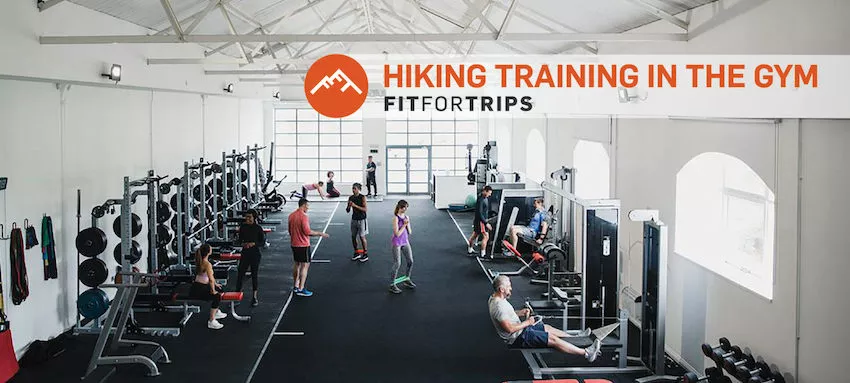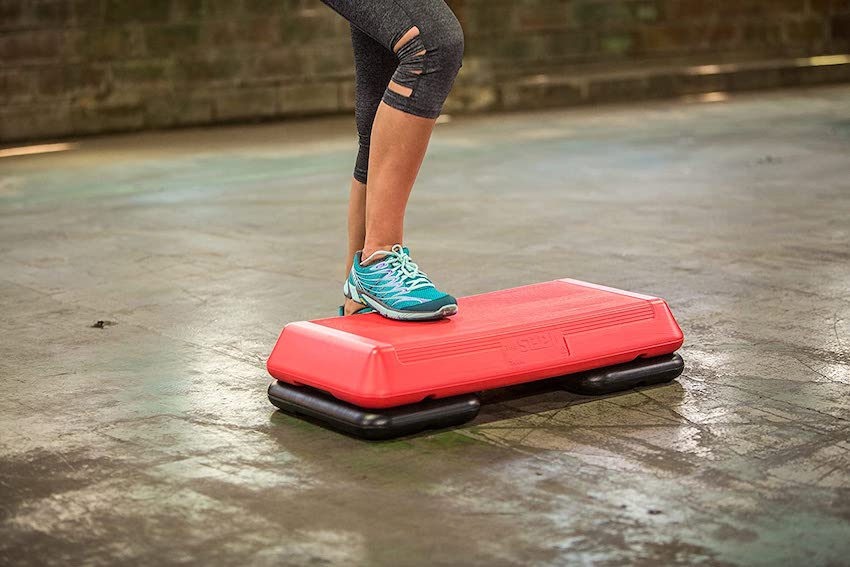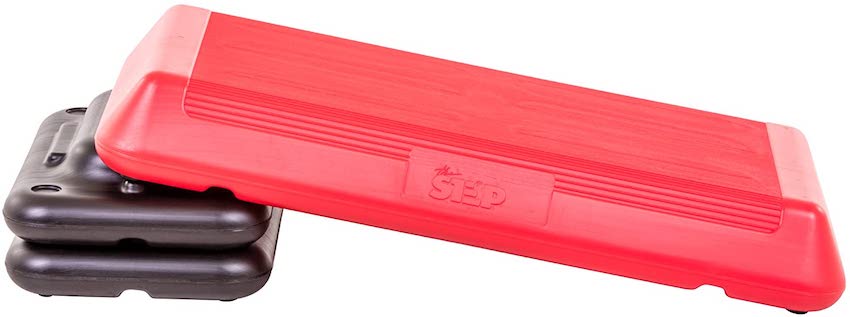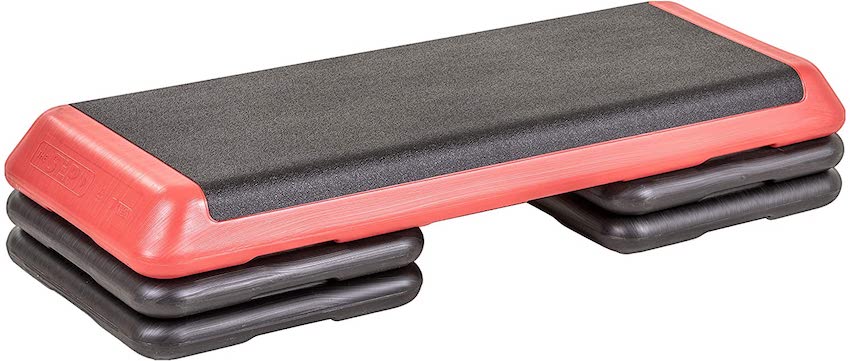How to Train for Hiking in the Gym – The Forgotten Element

What is the missing element to train for hiking in the gym?
Don’t overlook the aerobic step, which is a small elevated platform found in almost any gym, when you’re deciding how to train for hiking in the gym. It’s a simple tool to integrate into your gym regimen that will provide you with critical results. AND… after you read this article, be sure to check out the ELEVATION GAIN CALCULATOR for a STEP or BOX.
Why should you use an aerobic step? It’s simple: you will almost always miss the high repetitions of ground reaction forces (GRF) while training for your hikes in a gym unless you use an aerobic step. The exercises demonstrated in the videos below provide strength and endurance for ascending and descending, which are results you can’t get from just using the following equipment or exercises:
- Treadmill: Builds climbing endurance for all lower body muscles; incline setting lengthens Achilles tendons and calves.
- Elliptical: Cross training exercise for active recovery. Also used for high intensity interval training (HIIT) to build climbing endurance and higher altitude tolerance.
- Stair Stepper: Cross training exercise for active recovery. Also for HIIT for climbing endurance and higher altitude tolerance.
- Bodyweight training (i.e. lunges, squats, balance training): Strengthens muscles for climbing and descending as well as stepping onto and off of large rocks and fallen trees.
- Dumbbells and Barbells: Same as bodyweight training above, as well as strengthening the upper body to use hiking poles more effectively and enhance resistance for lower body training.
- Resistance Training Machines (i.e., leg press, leg extensions): Strengthens muscles for climbing and descending.
- Stationary Bike: Cross training exercise for active recovery or HIIT for higher altitude tolerance.
- Rowing machine: Cross training exercise for active recovery or HIIT for higher altitude tolerance.
All of the above have critical roles if applied effectively. Here are some references to help:
– How To Simulate Hiking on a Treadmill
– Hiking Workout for Legs Using Bodyweight and Dumbbells
– Cross Training Guide: Definition – Examples – Benefits
– Cori’s Best Hiking Exercise Picks – Round #1 of the Battle Royale
– Clay’s Best Hiking Exercise Picks – Round #2 of the Battle Royale
Why is the aerobic step important for gym training?
What are ground reaction forces as they relate to hiking? When you are hiking a trail, you need to get from point A to point B. You only get there by pushing your foot against the trail. The trail remains firm and pushes back against your foot and you propel forward. Repeat thousands of times, and with every independent ground reaction force you complete your hike. The aerobic step requires ground reaction forces to step onto and over the step – problem solved!
Every exercise mentioned above with the exception of squats, lunges or using bodyweight training, dumbbells, barbells, and some lower body machines will not provide ground reaction forces. Instead, they build strength without endurance. However, they all do have an application toward getting you in shape for hiking.
Check out aerobic step technique videos below
Videos are followed by strategies to include the aerobic step into your gym training routine for hiking.
Step Intro video.
Walk On/Off and Walk On/Off w/Tap demonstration.
Step Knee demonstration.
Jog On/Off , Jog On/Off w/Tap and Step Knee w/Power demonstration.
Over The Top demonstration.
Use a weighted pack while performing all aerobic step exercises.
How to train for hiking in the gym using the aerobic step
The examples below are for beginner to advanced exercisers:
1. Treadmill
Perform 5-10 minutes at 10% incline. Stop the treadmill and hop off carefully. Perform 5-10 minutes of any aerobic step technique. Repeat 1-5 times.
2. Elliptical / Stair Stepper / Stationary Bike / Any cardio machine
Perform 5-10 minutes at a moderate to high intensity. Hop off the machine safely. Perform 5-10 minutes of any aerobic step technique. Repeat 1-5 times.
3. Bodyweight training / Dumbbells and Barbells / Resistance Training Machines
Perform 2-5 different exercises with no rest between. Perform 5-10 minutes of any aerobic step technique. Repeat 1-5 times.
When you repeat the exercises you can switch the movements. For example, you can perform one set of lunges, lat pull downs, squats, and pushups, followed by 5 minutes of aerobic step. The next round you can do step ups, cable rows, single leg leanovers, and tricep pushdowns, or repeat the same initial movements for a second, third, fourth, or fifth set of each.
4. Aerobic Step
Perform aerobic step for one hour to songs at 120 BPM and get just under 2000 total steps. Generally speaking 2000 steps is considered industry standard for one mile. Use this calculator for more accurate total-steps-per-mile count.
 The Step Freestyle Aerobic Platform Compact Circuit Size (28.5” L x 14.5” W x 4”-6” Height)
The Step Freestyle Aerobic Platform Compact Circuit Size (28.5” L x 14.5” W x 4”-6” Height)
 The Step Freestyle Aerobic Platform Compact Circuit Size can be arranged into a slanted position. Simulate inclined trails for lengthening and strengthening the Achilles, calves and plantar fascia. (Incline Height 6”-8”)
The Step Freestyle Aerobic Platform Compact Circuit Size can be arranged into a slanted position. Simulate inclined trails for lengthening and strengthening the Achilles, calves and plantar fascia. (Incline Height 6”-8”)
 The Step Freestyle Aerobic Platform Health Club Size (43” L x 16” W x 4”-8” Height)
The Step Freestyle Aerobic Platform Health Club Size (43” L x 16” W x 4”-8” Height)
 The Step Freestyle Aerobic Platform Health Club Size can be arranged into a slanted position. Simulate inclined trails for lengthening and strengthening the Achilles, calves and plantar fascia. (Incline Height 6”-12”)
The Step Freestyle Aerobic Platform Health Club Size can be arranged into a slanted position. Simulate inclined trails for lengthening and strengthening the Achilles, calves and plantar fascia. (Incline Height 6”-12”)
How music assists you to train for hiking in the gym
Music is an important element of exercise, not just because it provides motivation but because it also encourages adherence to a particular pace on the aerobic step. You should add music as part of your hiking training routine – even if you have to dig out an old Walkman to do it.
You can train on the step with just bodyweight or with a loaded pack
Bodyweight stepping:
- Recommended speed of music: 120 beats per minute (BPM)
- Can be used for all stepping movements demonstrated
- 30 loaded steps will occur per minute
A loaded step is the foot that steps up onto the step; the foot is loaded while stepping up against gravity.
- 30 loaded steps will occur on the same foot when using the same lead-leg, i.e. Walk On/Off, Jog On/Off
- 15 loaded steps will occur on each foot when using alternating lead, i.e. Walk On/Off w/Tap, Step Knee, Over the Top, Step Knee w/Power
Stepping with an external load (i.e., backpack):
- Use a weighted backpack or dumbbells held in each hand (max pack weight approximately 30%-40% bodyweight or 40 lb)
- You can add weight to a traditional backpacking backpack
- Another option is a weighted vest
- Rucksacks are specific packs that have designed weight plates you insert into a secure sleeve
- Recommended speed of music: 80 BPM
- Can be used for all stepping movements demonstrated
- 20 loaded steps will occur per minute
- 20 loaded steps will occur on the same foot when using the same leg lead, i.e. Walk On/Off, Jog On/Off
- 1o loaded steps will occur on each foot when using alternating lead, i.e. Walk On/Off w/Tap, Step Knee, Over the Top, Step Knee w/Power
Considerations:
- These speeds are recommendations and can be adjusted to meet individual needs
- Keep in mind, the higher the step and the heavier the external load, the slower the BPM
- Many people can’t keep a beat to the rhythm of the music. However, this is not a problem as the music will still provide motivation.
How to find songs by BPM
Find songs by BPM using this website.
Every music app allows you to search playlists by BPM.

You can also search Google or any search engine for music playlists arranged by BPM.
Be creative with searches and you’ll find everything you need.

Ready to learn more about how to train for hiking in the gym? Contact us today for a free fitness consultation and we’ll set you down the path of being in shape for your next hiking adventure. Now it’s time to check out the ELEVATION GAIN CALCULATOR for an AEROBIC STEP or BOX.

Julian Howard
Really great exercises! While walking on a treadmill seems obvious, it’s genius to mimic the “hiking” motion by using a step. These would definitely be helpful warmups for beginner hikers, or for someone with bad knees who finds a once-a-week hike to be taxing on the joints. A nice steady pace is definitely achievable as long as you’ve got good music to pace yourself to. A few sets with your hiking boots or shoes (especially if they are new) will also help you get used to the “feel” of the hike. Definitely sharing this with our local hiking group. Cheers!